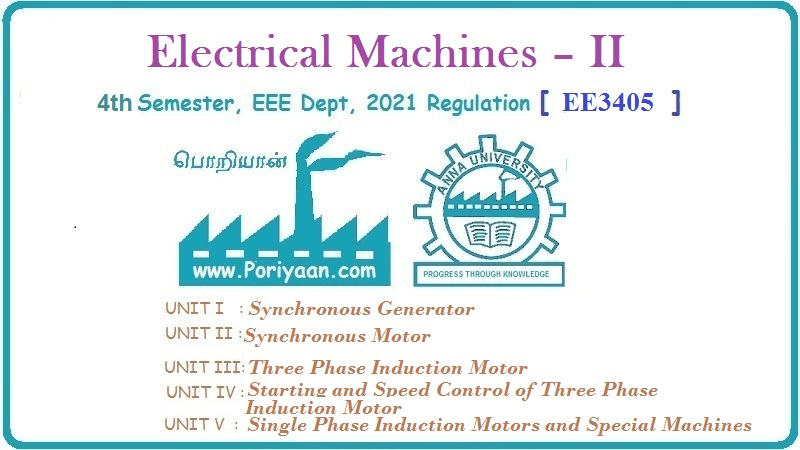Electrical Machines II: UNIT I: c. Synchronization and Parallel Operation of Alternators
Synchronization of Alternators by Lamp Method
In case of alternators, synchronization is done generally by lamp methods. It can be done by two ways : a) Lamps dark method b) Lamps bright method.
Synchronization of Alternators by Lamp Method
In
case of alternators, synchronization is done generally by lamp methods. It can
be done by two ways :
a)
Lamps dark method b) Lamps bright method.
1. Lamps Dark Method for Single Phase Alternators
In
this method the lamps are arranged as shown in Fig. 3.2.1. The alternator to be
synchronized (which is also called incoming alternator) consists of two lamps
connected across the switch terminals of the same phase.

The
voltage for the two alternators is measured with the help of a voltmeter. The
lamps are connected in such a way that the polarity and the frequency for the
two machines can be checked. No resultant voltage will appear across the switch
terminals if the frequency of the two alternators is exactly same as well as
their voltages are in exact phase opposition. Thus under this case lamps will
not glow. The voltages for both the machines are having same maximum and r.m.s.
values and are in exact phase opposition thus resultant voltage is zero in
local circuit. This is represented in the Fig. 3.2.2

It can be seen that with unequal frequencies
of the two alternators, the two lamps will become alternately bright and dark.
The light beat will be produced whose number is equal to the difference in
frequencies for the two machines.
The
resultant voltage appearing across the lamp will be difference of the two
voltages at any instant resulting in a waveform shown in the Fig. 3.2.3. Since
number of cycle completed by two machines in any given time are not same the light
beat is produced which is shown in the Fig. 3.2.3.

Whenever
the two voltages are in exact phase opposition (i.e. angle between them is
180°) then resultant voltage ER is zero. If the switch is not closed at this
instant the voltage across lamp will go on rising and synchronization will not
be proper.
The
alternate darkness and brightness of the lamp will not indicate whether the
incoming alternator is running fast or slow. For the exact synchronization the
speed of incoming alternator is adjusted in such a way that the light beats are
produced at a very slow speed and the alternators are synchronized during the
middle of the dark period where resultant voltage ER will be zero.
The word middle is used as the lamps will not glow even though there is
sufficient voltage across it. So it becomes difficult to know the correct
instant of zero voltage.
2. Lamps Bright Method
Since it is very difficult to judge the correct instant of zero voltage in Lamps dark method, this method is introduced which is shown in the Fig. 3.2.4.

The
lamps remain maximum bright when there is no difference in voltages for the two
machines. This is more sharp and accurate method of synchronization because the
lamps are much more sensitive to changes in voltage at their maximum brightness
than when they are dark.
3. Lamps Dark Method for Three Phase Alternators
In
this method, three lamps are used, which are connected as shown in the Fig.
3.2.5.

When
the voltages of busbar and incoming alternators are in phase opposition and
frequencies of both are exactly same no voltage appears across the switch and
lamps will not glow.
For
unequal frequencies, the lamps L1 L2 and L3
will flicker at a rate equal to difference in frequencies. If the phase
sequence is correct, all the lamps will become dark and bright simultanenously.
If this does not happen then two terminals of the incoming machine are
interchanged to correct the phase sequence. The frequency of the incoming
machine is so adjusted that lamp will flicker at very slow rate. The correct instant
of closing the switch is the middle of the dark period of the lamps L1
L2 and L3.
4. Disadvantages of Lamps Dark Method
1.
When there is large difference between the two voltages, the lamps become dark
as voltage across them is about half of their rated voltage. Hence faulty
synchronization may be done in the dark period which may damage the machine.
2.
This method does not given idea about how much the machine is slow or fast.
3.
Due to large voltage, lamps may burnout as lamp ratings are normally low. Hence
extra trasnsformer is required to step down the voltages which increases the
cost and complexity.
Hence
generally lamps bright and dark method is used.
Review Questions
1. Explain the synchronizing of 3 phase alternator by lamps dark
method.
2. Explain the synhronization of single phase alternators by
lamps dark method and lamps bright method.
3. State the disadvantages of lamps dark method of
synchronization.
Electrical Machines II: UNIT I: c. Synchronization and Parallel Operation of Alternators : Tag: Engineering Electrical Machines - II : - Synchronization of Alternators by Lamp Method
Related Topics
Related Subjects
Electrical Machines II
EE3405 Machine 2 EM 2 4th Semester EEE Dept | 2021 Regulation | 4th Semester EEE Dept 2021 Regulation
